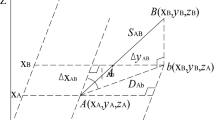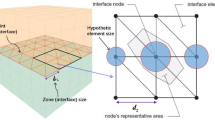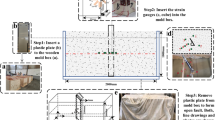Abstract
Anderson fault model is based on the Mohr-Coulomb criterion, a model to judge the occurrence of fault formation considering the value and direction of in situ stress. The purposes are to explore the similarities, differences, and applicability between the Anderson model and butterfly plastic zone theory in fault generation and reveal the characteristics of fault formation. First, the limitations of the Anderson fault model when applying to fault formation are emphasized. Second, the fundamental principles of butterfly plastic zone theory are introduced, and the mechanical conditions for the normal faults, reverse faults, and strike-slip faults are given. Finally, the three types of faults’ formation characteristics are reproduced through numerical simulation, and the Anderson model and butterfly plastic zone theory are compared and analyzed. Results demonstrate that the fault formation is affected by the direction and magnitude of the in situ stress. The relationship between the fault and the direction of the in-situ stress based on the model is consistent with the theoretical analysis. Compared with the Anderson model, the butterfly plastic zone theory can determine the precise fault locations and obtain the evolution process of reverse faults, normal faults, and strike-slip faults. The Anderson model is challenging to determine the precise fault locations and cannot display its formation process. A macroscopic judgment can find that butterfly plastic zone theory is more precise in determining fault formation.







Similar content being viewed by others
References
Anderson EM (1951) The dynamics of faulting and dyke formation with applications to Britain. oliver and Boyd, Edinburgh
Bernard C (2008) Seeking Anderson’s faulting in seismicity: A centennial celebration. Rev Geophys 46
Chen L, Jianbing P, Wen F et al (2007) Analysis of surrounding rockmass plastic zone of round tunnel under non-uniform stress field based on the unified strength theory. J China Coal Soc 32(1):20–23
Coulomb CA (1773) Essai sur une application des regles des maximis et minimis a quelques problemes de statique relatifs a 1’architecture. Mem Pres Par div Savants 7:343–382
Griffith AA (1921) The phenomena of rupture and flow in solid. Phil Trams Roy Soc, London, Ser A, A221:163–198
Guo X, Ma N, Xidong Z et al (2016) General shapes and criterion for surrounding rock mass plastic zone of round roadway. J China Coal Soc 41(8):1871–1877 (in Chinese)
He H, Su S, Mei H, Li P (2019) Numerical simulation of the mechanics of formation of a parallel reverse fault. Arab J Geosci
Jaeger JC, Cook NGW (1979) Fundamentals of rock mechanics, 3rd edn. Chapman and Hall, London, p 593
Ma N, Ji L, Zhiqiang Z (2015) Distribution of the deviatoric stress field and plastic zone in circular roadway surrounding rock. J China Univ Min Technol 44(2):206–213
Ma NJ, Guo XF, Zhao ZQ et al (2016) Occurrence mechanisms and judging criterion on circular tunnel butterfly rock burst in homogeneous medium. J China Coal Soc 41:2679–2688
Ma N, Xidong Z, Zhiqiang Z et al (2017) Conjecture about mechanism of butterfly-shape coal and gas outburst in excavation roadway. J Min Sci Technol 40(4):137–149
Qiao JY (2000) On the Preimages of Parabolic points. Nonlinearity 13:813–818
Qiao JY (2010) Complex dynamics of renormalization transformations. Science Press, Beijing (in Chinese)
Qiao J, Ma N, Ma J et al (2019) Conjugate fault-seismic composite model based on structural stability of dynamic system. J China Coal Soc 44(6):1637–1646
Shi HY (2020) Mechanics mechanism and its quantitative analysis of the formation of longmenshan faults. China University of Mining & Technology, Beijing (in Chinese)
Shi H, Ma N, Ma J (2018) Numerical simulation for the formation process of the Longmenshan fault zone and its crustal stress state. Chinese J Geophys 61(5):1817–1823
Shi H, Ma N, Jianjun S, Nan L, Ma J (2019a) Simulation on energy release of fault rock mass triggered by stress increment and discussion on seismogenesis: taking Longmenshan fault zone as an example (in Chinese). Acta Seismol Sin 41(4):502–511
Shi H, Ma N, Haitao X (2019b) Mechanism research on coal and gas outburst based on energy theory. J Safety Sci Technol 15(1):88–92
Tong H (2013) Mechanical model of brittle faulting in lithosphere. Chin J Nat 35(1):055–063
Wang W, Dong E, Chao Y (2019) Boundary equation of plastic zone of circular roadway in non-axisymmetric stress and its application. J China Coal Soc 44(1):105–114
Zhao Z, Ma N, Guo X et al (2016) Mechanism conjecture of butterfly rock burst in coal seam roadway. J China Coal Soc 41(11):2689–2697
Zhao ZQ, Ma NJ, Liu HT, Guo XF (2018) A butterfly failure theory of rock mass around roadway and its application prospect. J China Univ Min Technol 47(5):969–978
Acknowledgements
Thanks for the support of the Central University’s basic scientific research business funding (3142018022).
Author information
Authors and Affiliations
Corresponding author
Ethics declarations
Conflict of interest
The authors declare that they have no competing interests.
Additional information
Responsible Editor: Keda Cai
This article is part of the Topical Collection on Geological Modeling and Geospatial Data Analysis
Rights and permissions
About this article
Cite this article
Li, S., Ma, Z., Shi, H. et al. New understanding of Anderson fault formation model based on butterfly plastic zone theory. Arab J Geosci 14, 696 (2021). https://doi.org/10.1007/s12517-021-06876-z
Received:
Accepted:
Published:
DOI: https://doi.org/10.1007/s12517-021-06876-z




